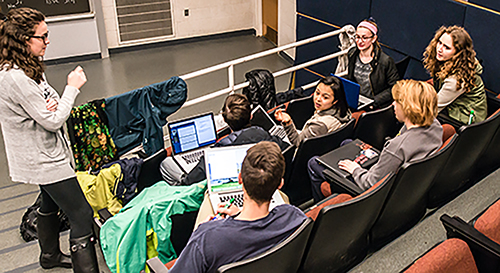 Given the research on the powerful impact of active engagement on student learning, many instructors at U-M are thinking about how they can increase opportunities for their students to be active and engaged. One way to accomplish this goal is to include case-based teaching in your courses. Case-based teaching is likely a familiar approach if you teach or study in the fields of law, medicine, or business. Funded by a grant from U-M’s Transforming Learning for a Third Century Initiative, the Michigan Sustainability Cases (MSC) project has been experimenting with ways to apply this pedagogy in a wider range of disciplines. A new CRLT Occasional Paper summarizes best practices and lessons learned from MSC that can help you integrate this approach into your teaching, whatever your discipline.
Given the research on the powerful impact of active engagement on student learning, many instructors at U-M are thinking about how they can increase opportunities for their students to be active and engaged. One way to accomplish this goal is to include case-based teaching in your courses. Case-based teaching is likely a familiar approach if you teach or study in the fields of law, medicine, or business. Funded by a grant from U-M’s Transforming Learning for a Third Century Initiative, the Michigan Sustainability Cases (MSC) project has been experimenting with ways to apply this pedagogy in a wider range of disciplines. A new CRLT Occasional Paper summarizes best practices and lessons learned from MSC that can help you integrate this approach into your teaching, whatever your discipline.
What exactly is case-based teaching? In brief, case-based teaching leverages real-world scenarios that require students to think critically and apply skills to solve problems and to explore divergent perspectives on an issue. As a result, it entails sustained interaction and dialogue between instructors and students, with the instructor guiding students through the process of discovery, rather than presenting information.
MSC has promoted the creation of rich, multimedia cases relevant to a wide range of disciplines connected to environmental sustainability. It has also established a community of instructors interested in writing and implementing case studies in their courses. The Occasional Paper describes how MSC has implemented case-based teaching in the field of environmental sustainability. It includes three sample cases that provide insight into MSC’s approach, along with guidelines for writing case studies. Readers will also find a discussion of challenges and lessons learned, as well as specific guidance for implementing case-based teaching in your own classroom.
For example, MSC has demonstrated that case studies excel at connecting theory to practice, providing a low-stakes environment for that practice, and fostering the development of critical thinking and perspective-taking skills. Key lessons that the authors highlight in the paper include the following:
- Case studies offer opportunities for deep, meaningful learning for both case producers and case users;
- Case studies connect teaching and research, and offer additional ways for faculty to build their scholarly portfolios;
- Using a case study can be a shared experience that anchors cohort formation among students new to a discipline or professional school;
- Case studies are flexible in form and method of deployment;
- Case studies can bring together disparate communities for problem solving and mutual learning.
If you are interested in guidance or collaborators for developing case studies, you can reach out to MSC. CRLT consultants are also available to support you in integrating a range of engaged instructional strategies into your specific teaching context, including case-based teaching.
- Log in to post comments
- 337 views








